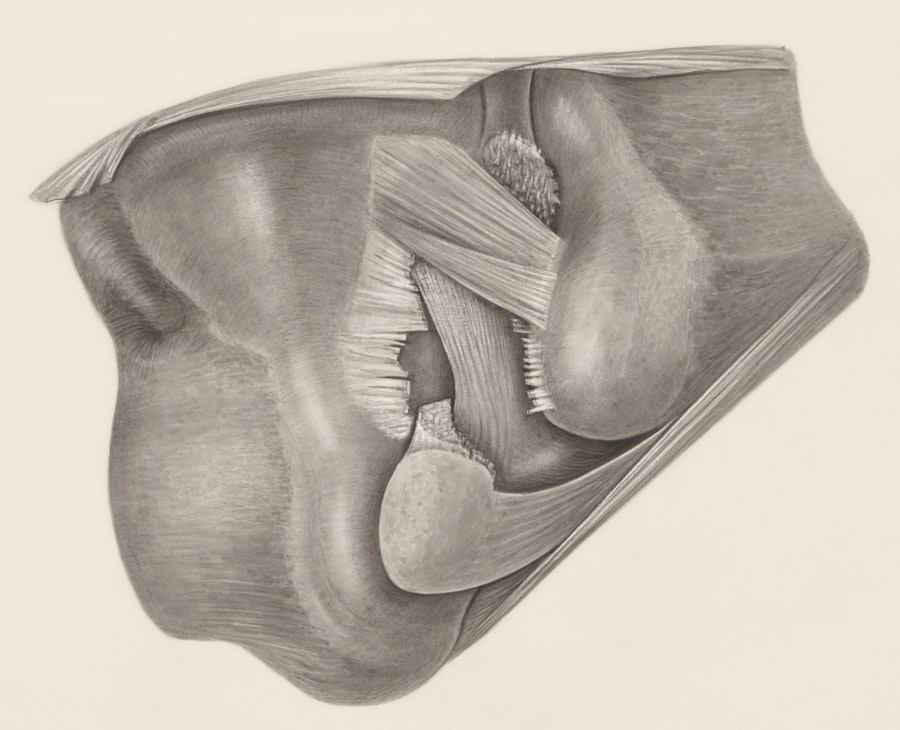Tendon avulsion is a serious injury that occurs when a tendon, which connects muscle to bone, is forcibly detached from its attachment point. This type of injury can lead to significant pain, loss of function, and a lengthy recovery process. When you experience a tendon avulsion, the body’s ability to perform certain movements is compromised, which can be particularly challenging for those who engage in physical activities like weightlifting.
Understanding the mechanics of this injury is crucial for anyone involved in sports or fitness, as it can help you recognize the signs and take preventive measures. The severity of a tendon avulsion can vary widely, ranging from partial tears to complete detachment. In some cases, the tendon may pull a small piece of bone with it, leading to an avulsion fracture.
This injury is not only painful but can also disrupt your training regimen and impact your overall fitness goals. Being aware of the implications of tendon avulsion can empower you to make informed decisions about your training and recovery strategies.
Key Takeaways
- Tendon avulsion occurs when a tendon is forcibly detached from the bone it is attached to, often due to sudden and excessive force.
- Common causes of tendon avulsion in weightlifting include lifting too heavy weights, improper technique, and overuse of muscles and tendons.
- Signs and symptoms of tendon avulsion may include sudden and severe pain, swelling, bruising, and difficulty moving the affected joint.
- Diagnosing tendon avulsion typically involves a physical examination, imaging tests such as X-rays or MRI, and possibly a referral to a specialist for further evaluation.
- Treatment options for tendon avulsion may include rest, ice, compression, elevation, physical therapy, and in severe cases, surgical intervention.
Common Causes of Tendon Avulsion in Weightlifting
In the realm of weightlifting, tendon avulsions often occur due to sudden, forceful movements or improper lifting techniques. When you lift heavy weights, especially during explosive movements like cleans or snatches, the risk of straining your tendons increases significantly. If you are not adequately warmed up or if you attempt to lift weights that exceed your current strength level, you may inadvertently place excessive stress on your tendons, leading to an avulsion.
Another common cause of tendon avulsion in weightlifting is the lack of proper progression in your training program.
Additionally, repetitive strain from performing the same movements without adequate rest can weaken the tendons over time, making them more susceptible to avulsion injuries.
Recognizing these risk factors is essential for maintaining a safe and effective weightlifting routine.
Signs and Symptoms of Tendon Avulsion

When you experience a tendon avulsion, the symptoms can manifest quite dramatically. One of the most immediate signs is a sudden, sharp pain at the site of the injury. This pain may be accompanied by swelling and bruising, which can develop rapidly as the body responds to the trauma.
You might also notice a decrease in strength or range of motion in the affected area, making it difficult to perform everyday tasks or continue with your weightlifting routine. In some cases, you may hear a popping or snapping sound at the moment of injury, which can be alarming.
As time goes on, you may experience stiffness and tenderness in the area, further complicating your ability to engage in physical activity. Being aware of these signs and symptoms can help you seek timely medical attention and prevent further complications.
Diagnosing Tendon Avulsion
| Study | Sensitivity | Specificity | Accuracy |
|---|---|---|---|
| Study 1 | 85% | 90% | 88% |
| Study 2 | 92% | 87% | 89% |
| Study 3 | 88% | 91% | 90% |
Diagnosing a tendon avulsion typically involves a combination of physical examination and imaging studies. When you visit a healthcare professional, they will likely begin by assessing your symptoms and conducting a thorough physical examination. They may check for tenderness, swelling, and range of motion in the affected area to determine the extent of the injury.
Imaging techniques such as X-rays or MRI scans are often employed to confirm the diagnosis and assess any associated damage. X-rays can help identify any avulsion fractures, while MRIs provide detailed images of soft tissues, including tendons. This comprehensive approach ensures that your healthcare provider has all the necessary information to develop an effective treatment plan tailored to your specific needs.
Treatment Options for Tendon Avulsion
The treatment options for tendon avulsion depend on the severity of the injury and whether surgical intervention is required. In cases where the avulsion is partial or if there is minimal damage to surrounding structures, conservative treatment methods may be sufficient. This typically includes rest, ice application, compression, and elevation (RICE) to reduce swelling and alleviate pain.
Your healthcare provider may also recommend over-the-counter pain relievers to help manage discomfort during the initial recovery phase. If the avulsion is more severe or if there is significant loss of function, surgical intervention may be necessary. In such cases, your healthcare provider will discuss the best surgical options available based on your specific injury and overall health.
Regardless of the treatment approach taken, it’s essential to follow your healthcare provider’s recommendations closely to ensure optimal healing and recovery.
Surgical Interventions for Tendon Avulsion

When conservative treatments fail to provide adequate relief or if the injury is severe enough to warrant surgery, various surgical interventions may be considered. The primary goal of surgery for tendon avulsion is to reattach the tendon securely to its original position on the bone. This procedure often involves suturing the tendon back into place or using anchors to secure it firmly.
Post-surgery, you will likely need to follow a structured rehabilitation program to regain strength and mobility in the affected area. The success of surgical intervention largely depends on how well you adhere to your rehabilitation plan and allow your body sufficient time to heal. Understanding the surgical process and what to expect afterward can help alleviate any anxiety you may have about undergoing such a procedure.
Rehabilitation and Recovery Process
The rehabilitation process following a tendon avulsion is crucial for restoring function and preventing future injuries. Initially, your focus will be on reducing pain and swelling through rest and gentle range-of-motion exercises as advised by your healthcare provider or physical therapist. Gradually, as healing progresses, you will begin incorporating strength training exercises tailored to your specific needs.
Throughout this process, it’s essential to remain patient and committed to your rehabilitation plan. Recovery timelines can vary significantly based on factors such as the severity of the injury and your overall health. Engaging in open communication with your healthcare team will ensure that you are on track with your recovery goals and can make any necessary adjustments along the way.
Preventing Tendon Avulsion in Weightlifting
Preventing tendon avulsion requires a proactive approach that emphasizes proper training techniques and body awareness. One of the most effective strategies is to gradually increase weights in your training regimen rather than making sudden jumps in intensity. This allows your tendons time to adapt and strengthen over time, reducing the risk of injury.
In addition to progressive loading, incorporating adequate warm-up routines before lifting sessions is essential. Dynamic stretching and mobility exercises can prepare your muscles and tendons for the demands of weightlifting. Furthermore, ensuring that you have rest days built into your training schedule allows for recovery and helps prevent overuse injuries that could lead to tendon avulsions.
Importance of Proper Technique and Form
Proper technique and form are paramount when it comes to weightlifting safety. When you lift with incorrect form, you place undue stress on your tendons and joints, increasing the likelihood of injury. It’s crucial to prioritize learning correct lifting techniques before attempting heavier weights.
Working with a qualified coach or trainer can provide valuable feedback on your form and help identify any areas that need improvement. Additionally, being mindful of your body mechanics during lifts can significantly reduce your risk of tendon avulsion. Focus on maintaining a stable core, using controlled movements, and avoiding jerky motions that could place excessive strain on your tendons.
By committing to proper technique, you not only enhance your performance but also safeguard against potential injuries.
The Role of Strength and Conditioning in Injury Prevention
Strength and conditioning play a vital role in preventing injuries like tendon avulsions in weightlifting. A well-rounded strength training program that targets all major muscle groups helps build overall stability and resilience in your body. By strengthening not just the muscles directly involved in lifting but also supporting muscle groups, you create a more balanced physique that can better withstand the stresses of weightlifting.
Incorporating functional movements into your conditioning routine can also enhance your body’s ability to handle various lifting scenarios safely. Exercises that mimic real-life movements improve coordination and proprioception, which are essential for maintaining control during lifts. By prioritizing strength and conditioning as part of your overall training strategy, you significantly reduce your risk of experiencing tendon avulsions.
Returning to Weightlifting After Tendon Avulsion
Returning to weightlifting after experiencing a tendon avulsion requires careful planning and consideration. It’s essential to consult with your healthcare provider or physical therapist before resuming any lifting activities. They will assess your recovery progress and provide guidance on when it’s safe for you to return to training.
When you do return to weightlifting, start with lighter weights and focus on perfecting your form before gradually increasing intensity. Listen to your body closely; if you experience any pain or discomfort during lifts, it’s crucial to stop immediately and reassess your approach. By taking a cautious yet determined approach to returning to weightlifting, you can minimize the risk of re-injury while gradually rebuilding strength and confidence in your abilities.
Tendon avulsion injuries, particularly those resulting from lifting heavy weights, are a significant concern for athletes and fitness enthusiasts. These injuries occur when a tendon is forcefully detached from the bone, often requiring surgical intervention and extensive rehabilitation. For those interested in understanding the biomechanics and prevention strategies related to such injuries, a related article on Freaky Science provides valuable insights. This article delves into the science behind tendon strength and the impact of various lifting techniques on tendon health. You can read more about it by visiting Freaky Science.
WATCH NOW! Your Brain Blocks Superhuman Strength – The Secret of the Pain Barrier
FAQs
What is a tendon avulsion injury?
A tendon avulsion injury occurs when a tendon is torn away from the bone it is attached to, often as a result of sudden or excessive force.
How does lifting cause tendon avulsion injuries?
Lifting heavy weights or objects can put significant stress on the tendons, especially if proper lifting techniques are not used. This can lead to tendon avulsion injuries, particularly in the shoulders, elbows, or knees.
What are the symptoms of a tendon avulsion injury from lifting?
Symptoms may include sudden and severe pain at the site of the injury, swelling, bruising, weakness, and difficulty moving the affected joint.
How are tendon avulsion injuries diagnosed?
A doctor will typically perform a physical examination and may order imaging tests such as X-rays, MRI, or ultrasound to confirm the diagnosis.
What are the treatment options for tendon avulsion injuries?
Treatment may include rest, ice, compression, and elevation (RICE), immobilization with a brace or splint, physical therapy, and in some cases, surgery to reattach the tendon to the bone.
What is the recovery time for a tendon avulsion injury from lifting?
Recovery time can vary depending on the severity of the injury and the individual’s overall health, but it may take several weeks to months for a full recovery. Physical therapy is often recommended to regain strength and range of motion in the affected joint.
